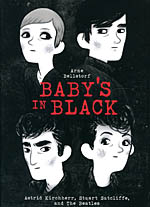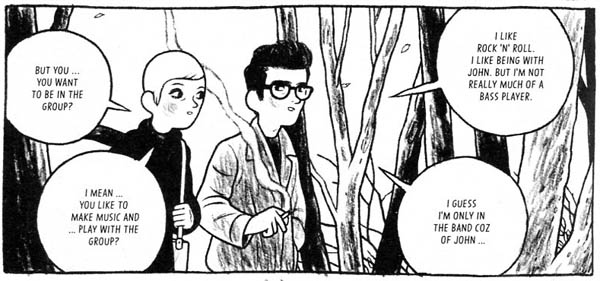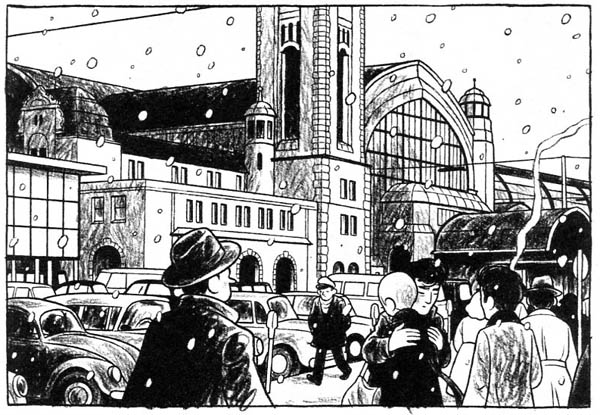 By Arne Bellstorf
By Arne Bellstorf
208 pages, black and white
Published by First Second Books
I’ll admit that before reading Baby’s in Black: Astrid Kirchherr, Stuart Sutcliffe, and The Beatles, I knew remarkably little about Stuart Sutcliffe, one of the early members of the Beatles. So it was with that in mind that I was eager to read Arne Bellstorf’s biography of Sutcliffe and photographer Astrid Kirchherr’s life together, a glimpse into the early days when the Beatles were a five-piece band and playing in Germany. What I found was a book that answered a lot of questions, but ultimately left me feeling a little frustrated by what I had and hadn’t learned.
Despite the subtitle of Baby’s in Black, one thing should be made immediately clear: this isn’t a book about the Beatles, it’s about Kirchherr and Sutcliffe. Sure, the other members of the Beatles appear, but they’re at best secondary characters and bordering on background. (Pete Best is so rarely even mentioned that initially I found myself wondering if Best had even joined the band yet.) Once you get past that, though, you’ve got a charming love story, told from Kirchherr’s point of view. Because Baby’s in Black is exclusively from Kirchherr’s side, the book delves deep into her head about her confusion and attraction when it comes to Sutcliffe, as she tries to figure out who exactly this British rocker is. Bellstorf gets across how quickly Kirchherr falls for Sutcliffe, and I think that’s probably the most effective part of the book.

Despite the fact that Baby’s in Black takes place over just a few years, though, the book comes across as feeling compressed and truncated in parts. Kirchherr is probably best known for her photographing the group during the A Hard Day’s Night shoot, but that’s nowhere in the book. Even the one photography session she does with the band is glossed over, relegated to just a couple of pages and then quickly sliding past it. Doing some research it’s made clear that Kirchherr always preferred to be thought of as a friend of the Beatles rather than someone who had strictly a business relationship with them, and Bellstorf’s glossing over that aspect seems to be a direct result. But even then, it’s hard to feel Kirchherr’s relationship with anyone but Sutcliffe in Baby’s in Black; Lennon at least has a minor role, but the other members are in so little of the book that it feels a little disingenuous to even have Lennon and McCartney’s portraits on the cover. (At least Harrison and Best don’t appear there, because they’re at a "blink-and-you’ll-miss-them" level of involvement.) I feel like Baby’s in Black is only telling half of a story, and it’s frustrating because I’d have liked to see Bellstorf’s take on the rest of Kirchherr’s connection with the Beatles.
Bellstorf’s art in Baby’s in Black is drawn in soft, almost fuzzy lines. It’s an attractive initial look, reminding me of charcoal sketches but with just a tad more clarity. I love the shading that he applies to his art; instead of completely filling in his blacks, he leaves them at about 90%, with little peeks of white sneaking through the textured look. On the down side, a lot of the characters look awfully similar to one another in Baby’s in Black. There are some exceptions—Lennon in particular never looks like anyone but himself—but I feel like Bellstorf has a limited number of facial features that he can draw. Everyone except for Lennon has the same nose, for instance, and eyebrows are always thick and busy or pencil thin, with no in-betweens. Fortunately there isn’t a large cast for Baby’s in Black, but even then I felt like a little more differentiation would have been nice. Still, when it comes to backgrounds and setting the scene for Baby’s in Black, Bellstorf does a great job; I really felt like I was getting a small tour of Hamburg through the illustrations.

Baby’s in Black is ultimately a good book that I wish had been great. It’s got a good core story, but it left me wanting a lot more detail and information that wasn’t present. I feel like Bellstorf stuck rigidly to the one aspect of the Beatles’ time in Germany that he wanted to tell a story about (Kirchherr’s and Sutcliffe’s relationship), but even that gets skimmed over in places, especially towards the end. It’s a good start if you’re interested in the early days of the Beatles, but I can’t help but feel like it’s best looked at as a stepping stone to larger, more robust books on the subject. It’s good for what it is, though, and I’m definitely glad I read it.
Purchase Links: Amazon.com | Powell’s Books

I felt a little less than you did about this comic. It was as weak as it was good and left me feeling very indifferent about it.